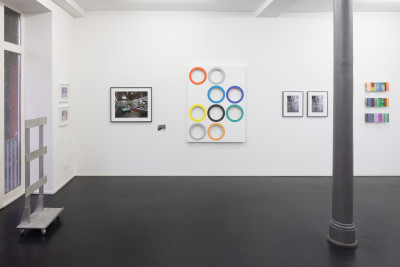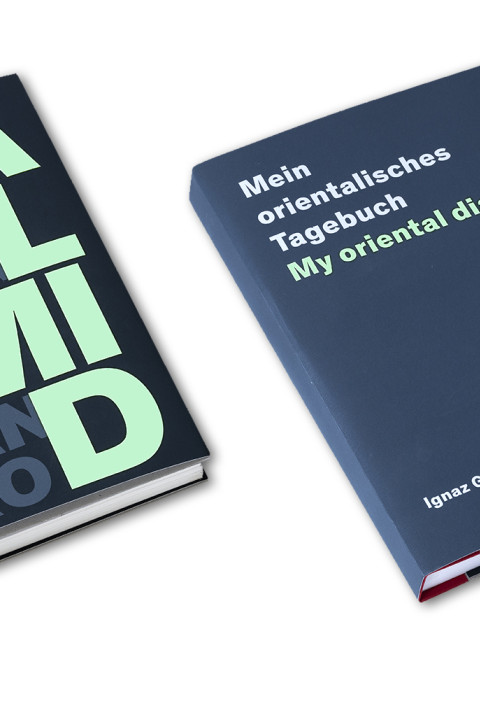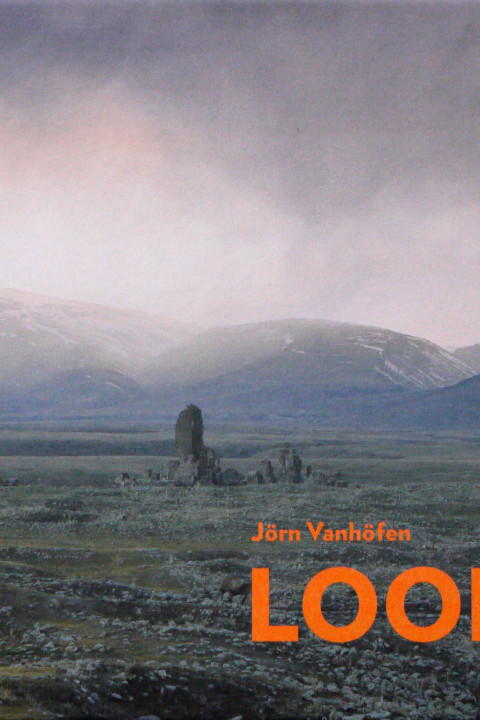Jörn Vanhöfen
-
 TALMIDBitter Edition Berlin, 2021
TALMIDBitter Edition Berlin, 2021Jörn Vanhöfen
TALMID
two artists books:
TALMID (with photographs by Jörn Vanhöfen)
MEIN ORIENTALISCHES TAGEBUCH (reproductions from a travel diary by Ignaz Goldziher)
with a text by Navid Kermani
German/Englisch
40 photographs as giclèe print on Japanese washi paper
handbound
Edition: 10 + 124,5 x 32,5 cm
Bitter Edition Berlin, 2021
Euro 1800,00 -
 LoopKuckei + Kuckei, 2015
LoopKuckei + Kuckei, 2015Jörn Vanhöfen
Loop
Vanhöfen's pictures bear witness to the metamorphosis of material; to both small and gigantic upheavals. The melting of the glaciers cannot be prevented, not even by cleverly applied layers of insulation. Areas of the earth are now being exposed that were covered for thousands of years. New continents make their appearance while vast tracts of coastline are about to vanish from the map. But this future is not an apocalyptic vision, but rather a vision of Nature that will inevitably re-conquer its domain in some future post-human era.
58 pages
24,5 × 27,5 cm
Kuckei + Kuckei, 2015
ISBN 978-3-00-047796-6
Euro 25,00 -
 AftermathHatje Cantz, 2011
AftermathHatje Cantz, 2011Jörn Vanhöfen
Aftermath
Photographer Jörn Vanhöfen (*1961 in Dinslaken) travels the world to capture images of areas that are undergoing rapid change. They are always places where people believe wholeheartedly in permanent growth and limitless profit, for the consequences of this fatal attitude are the objects of his photographic work. Vanhöfen journeys to Africa, Europe, Asia, and North America, going wherever the results are demonstrably obvious—from the Chicago stock exchange, the townships of Cape Town, and the scorched forests in Apulia to abandoned factories in Detroit and salvage yards in his hometown in the Ruhr region. His unique, poetic photographs depict ruins of our time. And while they may be fascinatingly beautiful, the looming consequences of our actions at the same time horrify us.
148 pages
34,8 × 28,9 cm
Hatje Cantz, 2011
ISBN 978-3-7757-2975-8
Euro 58,00
Jörn Vanhöfen was born 1961 in Dinslaken, Germany. Studied from 1985-1988 at Folkwang Schule, Essen and from 1989 – 1993 at the Hochschule für Grafik und Buchkunst, Leipzig. Jörn Vanhöfen lives and works in Berlin.
Solo Shows
-
2016
Zwischenzeit: 1989 – 1991, Kuckei + Kuckei, Berlin, Germany
Loop – Jörn Vanhöfen, Museum Haus Ludwig, Saarlouis, Germany
-
2015
Jörn Vanhöfen – Loop, Alfred Ehrhardt Stiftung, Berlin, Germany
Jörn Vanhöfen – Loop, Opelvillen, Rüsselsheim, Germany
-
2014
Jörn Vanhöfen – Aftermath, FO.KU.S – Foto Kunst Stadtforum, Innsbruck, Austria
Beyond Eden, Galerie Roemerapotheke, Zurich, Switzerland
-
2013
Disturbia, Kuckei + Kuckei, Berlin, Germany
Grenzenlos, Kunstverein Konstanz, Konstanz, Germany
-
2012
Aftermath, Robert Mann Gallery, New York City, NY
-
2011
Kuckei + Kuckei, Berlin, Germany
-
2010
Die Elbe, Oldenburger Landesmuseum, Oldenburg, Germany
-
2009
Aftermath, Kuckei + Kuckei, Berlin, Germany
-
2008
Galerie Römerapotheke, Zurich, Switzerland
-
2007
Aftermath, Kuckei + Kuckei, Berlin, Germany
-
2006
Kulturhaus Osterfeld, Pforzheim, Germany
-
2005
K. Galerie, Lissabon, Portugal
-
2004
Galerie Römerapotheke, Zurich, Switzerland
-
2001
Kunstverein Glückstadt, Glückstadt, Germany
Altonaer Museum, Hamburg, Germany
-
1998
Altonaer Museum Hamburg, Germany
Kulturhaus Aalen, Aalen, Germany
-
1997
Instituto Cervantes, Rome, Italy
-
1996
Instituto Cervantes, Bremen, Germany
Museum Velbert, Velbert, Germany
Habana Vieja, Göttingen, Germany
-
1995
Haus der Kulturen der Welt, Berlin, Germany
-
1994
Centro Cultural Jose Marti, Mexico City, Mexico
Goethe Institut, Mexico City, Mexico
Universität Monterey, Monterey, Uruguay
-
1993
Hochschule für Grafik und Buchkunst, Leipzig, Germany
Fototeca de Cuba, Havanna, Cuba
Group Shows
-
2017
The Wall, Podbielski Contemporary, Berlin
-
2016
Accrochage +, dr. julius | ap, Berlin, Germany
-
2014
Am Ende der Sehnsucht – Fotografische Positionen zu Tod und Meer, kunst:raum sylt quelle, Rantum / Sylt, Germany
-
2013
Obscure, Villa Renata, Basel, Switzerland
Am Ende der Sehnsucht – Fotografische Positionen zu Tod und Meer, Altonaer Museum für Kunst und Kulturgeschichte, Hamburg, Germany
-
2012
Lost Places – Orte der Photographie, Galerie der Gegenwart, Hamburger Kunsthalle, Hamburg, Germany
Bildspuren – Unruhige Gegenwart, 7. Darmstädter Tage der Fotografie, Darmstadt, Germany
-
2011
Leipzig.Fotografie / 1839-2011, Museum der bildenden Künste, Grassi Museum für Angewandte Kunst und Stadtgeschichtliches Museum, Leipzig, Germany
-
2010
10 Jahre Kunstverein Glückstadt, Palais für aktuelle Kunst, Glückstadt, Germany
HomeLessHome, Museum on the Seam, Jerusalem, Israel
-
2009
Nation and Nature, Museum on the Seam, Jerusalem, Israel
-
2007
… und grüßen Sie mir die Welt/fotografierte Heimaten, Stuttgart, Germany
Weather Report, Centro Atlantico de Arte Moderno, Las Palmas, Canary Islands
-
2006
Kunstsalon, Berlin, Germany
-
2005
Berlin Photographers, Rencontres de la Photographie, Aix-en-Provence, France
HKM Projekt in Zusammenarbeit mit der Stiftung Wilhelm Lehmbruck Museum, Duisburg, Germany
-
2003
Teutonen Pop, Stanford University, CA
-
2000
Östlich von Eden, Kasseler Kunstverein, Kassel, Germany
Goethe Institut, Mexiko City, Mexico
Centro Cultural Aleman, Monterrey, Uruguay
Haus der Geschichte, Bonn, Germany
-
1999
Östlich von Eden, Postfuhramt Berlin, Berlin, Germany
-
1998
Augenzeugen, Goethe Institute in Rome, Madrid, Helsinki, Mexiko City, Barcelona, Paris, Seoul, Tokio
-
1997
Willy Brandt Haus, Berlin, Germany
-
1993
100 Jahre Photographie in Leipzig, Leipzig, Germany
-
1992
Turning Points. East German Art in Revolution, Sunderland, Carlisle, Aberystwth, Sheffield, Bradfort, Newcastle, London, Great Britain
Kunstverein Heilbronn
Leipziger Schule, Castrop Rauxel, Germany
-
1990
Gallery Kuba, Tokio, Japan
-
1989
Gerrit Academy, Amsterdam, Netherlands
Public Collections
-
Art Gallery of Ontario
The Progressive Art Collection, OH
Landesbank Baden-Württemberg, Stuttgart
HessKiss Collection, Zurich
AXA – Winterthur, Art Collection, Zurich
Museum on the Seam, Jerusalem
Jerry Speyer Art Collection, New York




















